Mexico Diabetes Drugs and Devices Market Size
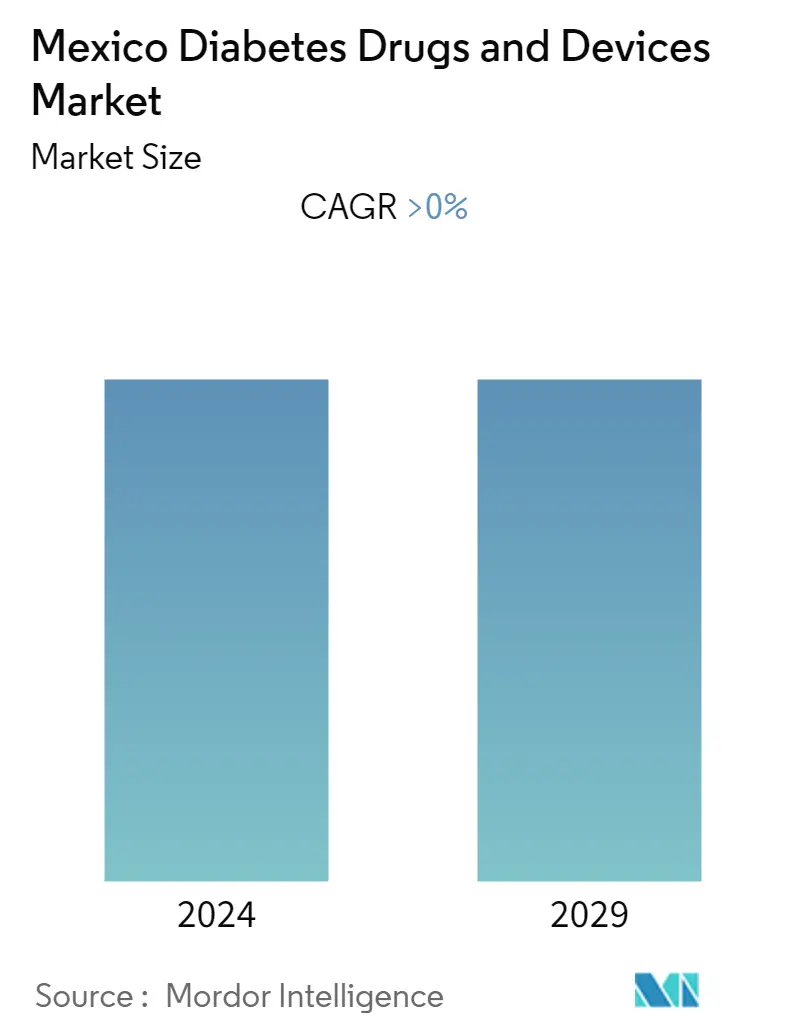
| Study Period | 2018 - 2029 |
| Base Year For Estimation | 2023 |
| Forecast Data Period | 2024 - 2029 |
| Historical Data Period | 2018 - 2022 |
| CAGR | 0.00 % |
Major Players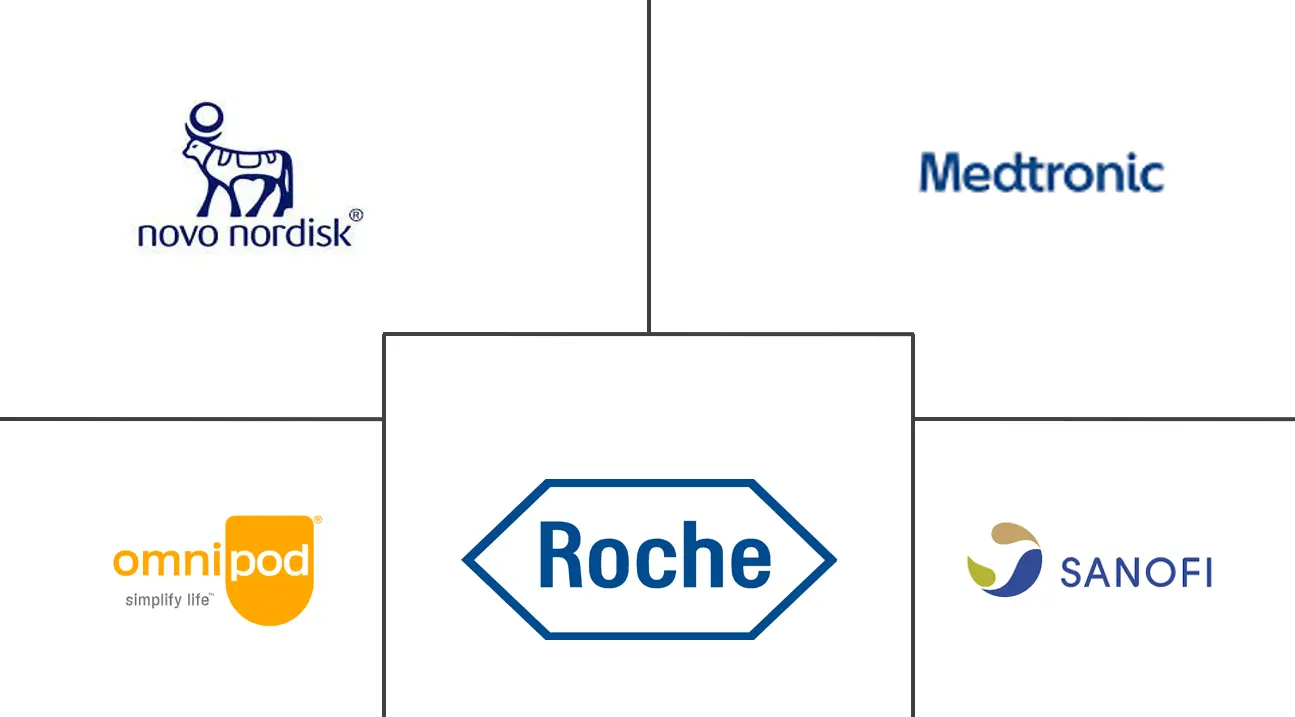
*Disclaimer: Major Players sorted in no particular order |
Mexico Diabetes Drugs and Devices Market Analysis
Mexico's diabetes drugs and devices market size is estimated at USD 2.4 billion in the current year. The market is expected to reach USD 2.9 billion in five years, resitering a CAGR of more than 3.8% during the forecast period.
The COVID-19 pandemic has significantly impacted the diabetes care device market. Diabetes is a chronic disease that requires self-management and care. This includes regular attention to diet, physical activity, blood sugar monitoring, and taking medications. People with chronic diseases such as diabetes and obesity have a poor prognosis for COVID-19. A person with diabetes is twice as likely to develop comorbidities and die. Prepare your healthcare system for more severe cases of COVID-19, as studies suggest that poor glycemic control increases the risk of adverse outcomes in people with diabetes with SARS-CoV-2 infection. It needs to be better organized. Due to the prevalence of diabetes in patients hospitalized with COVID-19 and the recognition that improved glycemic control may improve outcomes and reduce the length of stay in patients with COVID-19 diabetes treatment, The importance of equipment is emphasized.
Diabetes prevalence in Mexico is currently 16.9%, or 1 in 6 adults, according to the IDF Diabetes Atlas 2021. This is a 10% increase over the last two years. Additionally, 11 million adults in the country have impaired glucose tolerance (IGT), putting them at high risk of developing type 2 diabetes. Diabetes-related healthcare spending in Mexico reached US$20 billion, making it one of the top 10 countries or regions with the highest overall healthcare spending. Less than half (47.5%) of people living with diabetes in this country are undiagnosed.
Suppose diabetes is not diagnosed or properly treated. In that case, people with diabetes risk serious and life-threatening complications such as heart attack, stroke, kidney failure, blindness and lower limb amputation. This leads to a lower quality of life and higher healthcare costs, increasing the need for access to healthcare. In Mexico, diabetes, especially type 2 diabetes, is the leading cause of death among women and the second leading cause of death among men, thus burdening healthcare. Factors that contribute to the development of diabetes include obesity, lack of exercise, poor eating habits, genetics, family background, and age.
Thus, the above factors are expected to drive market growth over the forecast period.
Mexico Diabetes Drugs and Devices Market Trends
The continuous Glucose Monitoring Segment is Expected to Witness the Highest Growth Rate Over the Forecast Period
Continuous blood glucose monitoring is a popular alternative to commercially available portable finger glucose meters for people with diabetes. The sensor is the most important part of any constant blood glucose monitoring device. Various promising glucose sensor technologies are being developed, ranging from traditional electrochemical glucose sensors to new optical and other electrical glucose sensors, positively impacting the market growth. Continuous blood glucose monitoring sensors have opened new scenarios for offline assessment of the efficacy of treatment regimens for individual patients, facilitating the development of innovative online applications. This includes a hypoglycemia and hyperglycemia warning system and an artificial pancreas control algorithm. With new technologies, continuous blood glucose monitoring devices are becoming increasingly inexpensive.
Pharmacies are considered essential tools for better healthcare in Mexico. The pharmaceutical industry has integrated technology tools. Through the Beyond the Pills initiative, companies complement drug treatments with digital platforms, facilitating follow-up and ensuring continuity of care. Roche is one of the companies taking a "Beyond the Pills" approach to treating diabetes. The pharmaceutical company offers a digital platform for diabetes treatment called mySugr. This will enable Roche to provide accessible patient solutions within an open platform to address unmet needs. The goal is to help people with diabetes spend more time within their ideal glycemic target range and improve their quality of life. mySugr allows users to automatically upload their blood sugar data from their preferred device to the mySugr Logbook app and share data with medical professionals and caregivers.
In addition, current continuous blood glucose monitors can retroactively check blood glucose trends by downloading data or providing real-time images of blood glucose levels via the receiver display. New technologies such as cell phone integration are making continuous glucose monitoring devices increasingly affordable. This is likely to drive the growth of the segment during the forecast period.
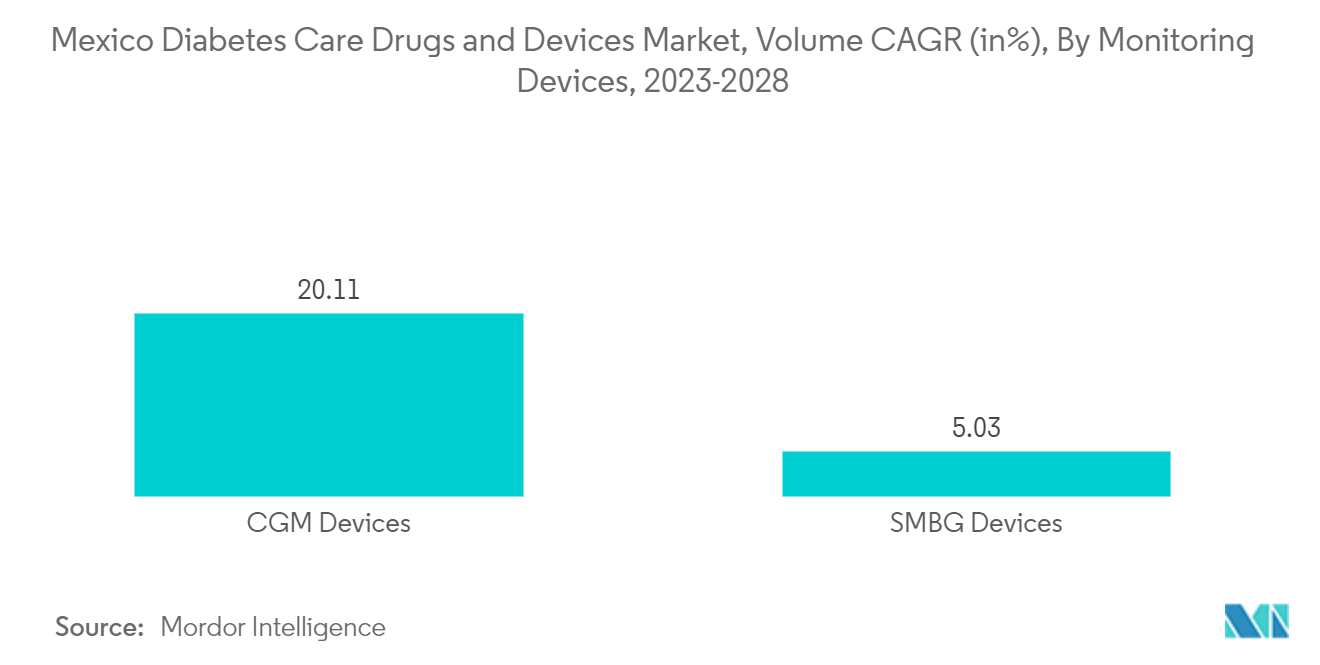
Rising diabetes prevalence
Lack of health insurance keeps low-income people out of service and puts them at risk of financial hardship. Mexico has introduced mechanisms such as community-based health insurance, state health insurance, and targeted public health insurance to protect people from excessive healthcare spending. There are several health insurance providers in Mexico. The Instituto de Seguridady Servicios Sociales de los Trabajadores del Estado [Institute of Social Security and Social Services for Government Employees, ISSSTE] serves civil servants. In contrast, the Instituto Mexico del Segura Social [Mexico Social Security Institute, IMSS] serves the private sector. It is intended for employees. Segro Popular [National Insurance] was created to protect the working-age population from high medical costs. Enrollment in Segro Popular is independent of any health condition or previous illness. There are no out-of-pocket costs based on the type of medical care received; family contributions are determined solely by the ability to pay. The Mexican government has worked with many private companies to leverage their supply chains and ensure low prices for their devices. Diabetes is a major public health problem and one of the extraordinary challenges facing healthcare systems across Mexico. The increasing incidence, prevalence, and progression of the disease have prompted the development of new drugs that provide additional treatment options for patients with diabetes. Market opportunities for diabetes therapeutics market players include numerous new product launches, increased international research collaboration for technological advancement, and increased public awareness of diabetes.
The increasing diabetes prevalence and the above factors will likely drive segment growth over the forecast period.
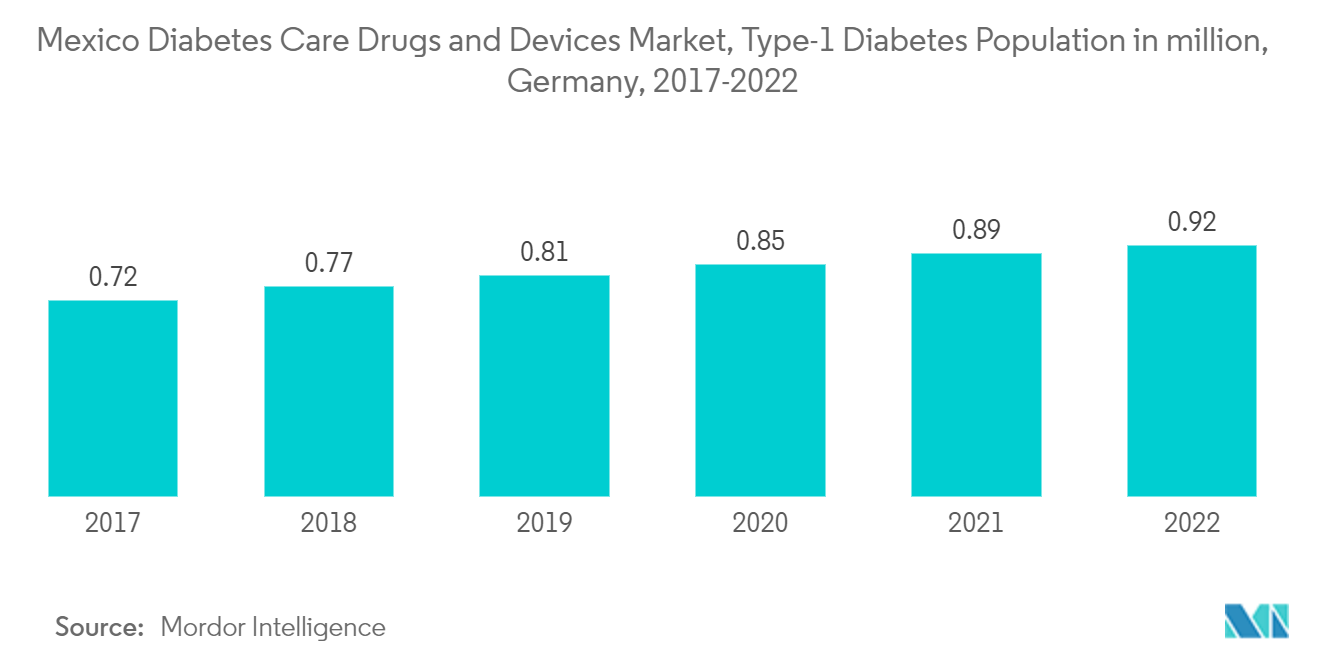
Mexico Diabetes Drugs and Devices Industry Overview
The manufacturers of insulin delivery devices are spending a huge amount on the R&D of the devices. For example, Novo Nordisk partnered with Abbott Diabetes Care, which may also assist to enable insulin statistics to be shared between Novo Nordisk-connected insulin pens and digital fitness equipment well suited to the FreeStyle Libre portfolio of products.
Mexico Diabetes Drugs and Devices Market Leaders
-
Medtronics
-
Roche
-
Sanofi
-
NovoNordisk
-
Omnipod
*Disclaimer: Major Players sorted in no particular order
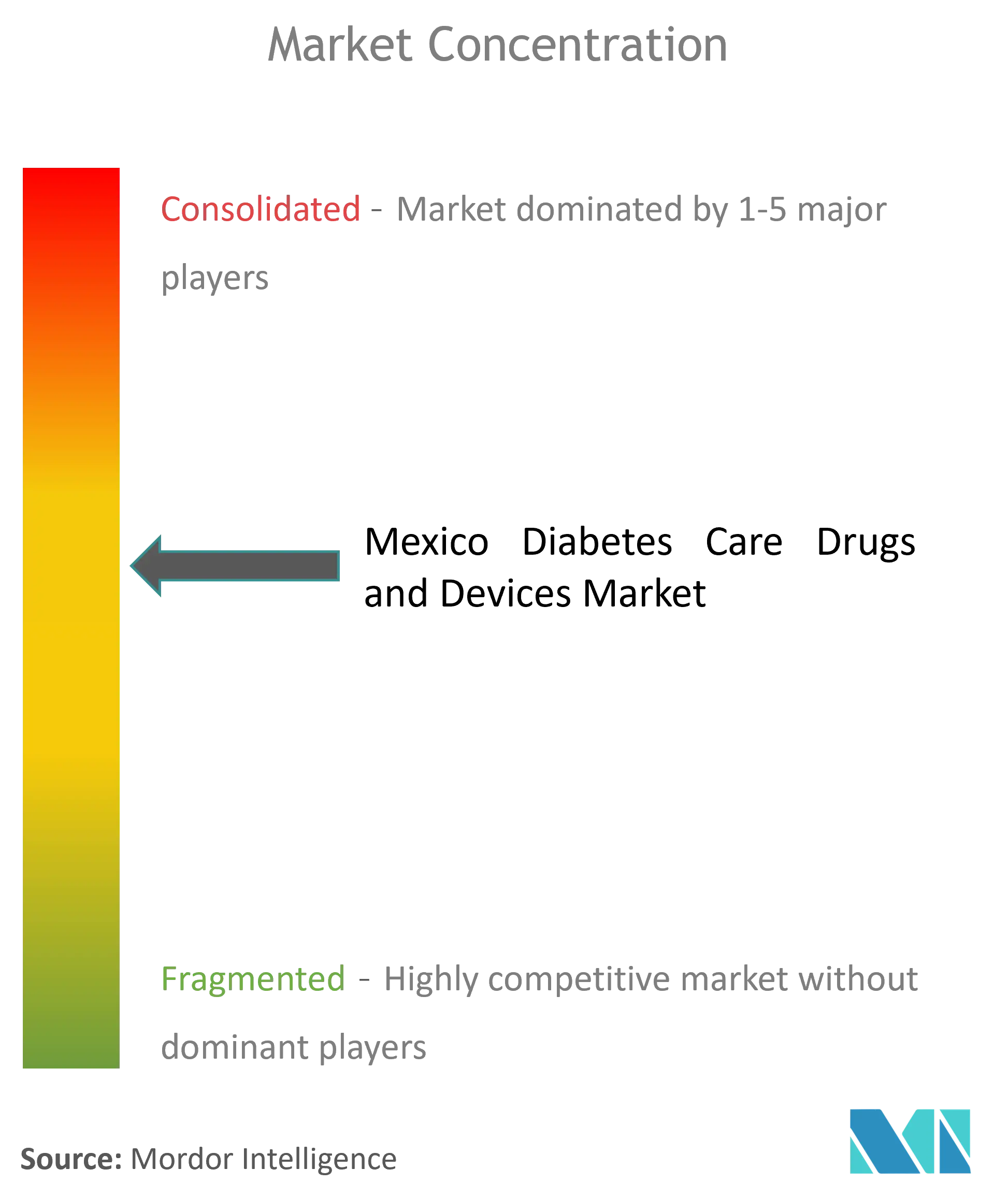
Mexico Diabetes Drugs and Devices Market News
- October 2022: Becton, Dickinson, and Company and Biocorp signed an agreement to use connected technology to track adherence to self-administered drug therapies, like biologics. To support biopharmaceutical companies in their efforts to improve the adherence and outcomes of injectable drugs, the two companies will integrate Biocorp's Injay technology. It is a solution designed to capture and transmit injection events using Near Field Communication technology to the BD UltraSafe Plus Passive Needle Guard used with pre-fillable syringes.
- March 2022: Oramed announced ORMD-0801 (a new molecule) is being evaluated in two pivotal Phase 3 trials and can be the first oral insulin capsule with the most convenient and safest way to deliver insulin therapy. This drug is expected to be a game-changer in the insulin and oral anti-diabetes drugs markets.
Table of Contents
1. INTRODUCTION
- 1.1 Study Assumptions and Market Definition
- 1.2 Scope of the Study
2. RESEARCH METHODOLOGY
3. EXECUTIVE SUMMARY
4. MARKET DYNAMICS
- 4.1 Market Overview
-
4.2 Market Dynamics
- 4.2.1 Market Drivers
- 4.2.2 Market Restraints
-
4.3 Porter's Five Forces Analysis
- 4.3.1 Bargaining Power of Suppliers
- 4.3.2 Bargaining Power of Consumers
- 4.3.3 Threat of New Entrants
- 4.3.4 Threat of Substitute Products and Services
- 4.3.5 Intensity of Competitive Rivalry
5. Market Segmentation (Market Size by Value - USD)
-
5.1 Devices
- 5.1.1 Monitoring Devices
- 5.1.1.1 Self-monitoring Blood Glucose Devices
- 5.1.1.2 Continuous Blood Glucose Monitoring
- 5.1.2 Management Devices
- 5.1.2.1 Insulin Pump
- 5.1.2.2 Insulin Syringes
- 5.1.2.3 Insulin Cartridges
- 5.1.2.4 Disposable Pens
-
5.2 Drugs
- 5.2.1 Oral Anti-Diabetes Drugs
- 5.2.2 Insulin Drugs
- 5.2.3 Combination Drugs
- 5.2.4 Non-Insulin Injectable Drugs
6. Market Indicators
- 6.1 Type-1 Diabetes Population
- 6.2 Type-2 Diabetes Population
7. COMPETITIVE LANDSCAPE
-
7.1 Company Profiles
- 7.1.1 Novo Nordisk
- 7.1.2 Medtronic
- 7.1.3 Insulet
- 7.1.4 Tandem
- 7.1.5 Ypsomed
- 7.1.6 Novartis
- 7.1.7 Sanofi
- 7.1.8 Eli Lilly
- 7.1.9 Abbottt
- 7.1.10 Roche
- 7.1.11 Astrazeneca
- 7.1.12 Dexcom
- 7.1.13 Pfizer
- *List Not Exhaustive
- 7.2 Company Share Analysis
8. MARKET OPPORTUNITIES AND FUTURE TRENDS
** Subject To AvailablityMexico Diabetes Drugs and Devices Industry Segmentation
Patients with type 1 diabetes must be given insulin because their pancreas cannot process it. to control blood sugar levels, insulin must be given several times a day, such as when eating or drinking. many people with type 2 diabetes also need to take antidiabetic drugs. these drugs include diabetes medications and injections such as insulin. Mexico's diabetes drugs and devices market is segmented by drugs (insulin, oral anti-diabetic drugs, non-insulin injectable drugs, and combination drugs), and devices ( management devices (insulin pumps, insulin pens, syringes, cartridges, and jet injectors) and monitoring devices (self-monitoring blood and continuous glucose monitoring)). the report offers the value (in USD) and volume (in unit) for the above segments.
| Devices | Monitoring Devices | Self-monitoring Blood Glucose Devices |
| Continuous Blood Glucose Monitoring | ||
| Devices | Management Devices | Insulin Pump |
| Insulin Syringes | ||
| Insulin Cartridges | ||
| Disposable Pens | ||
| Drugs | Oral Anti-Diabetes Drugs | |
| Insulin Drugs | ||
| Combination Drugs | ||
| Non-Insulin Injectable Drugs |
Frequently Asked Questions
What is the current Mexico Diabetes Drugs and Devices Market size?
The Mexico Diabetes Drugs and Devices Market is projected to register a CAGR of greater than 0% during the forecast period (2024-2029)
Who are the key players in Mexico Diabetes Drugs and Devices Market?
Medtronics , Roche, Sanofi, NovoNordisk and Omnipod are the major companies operating in the Mexico Diabetes Drugs and Devices Market.
What years does this Mexico Diabetes Drugs and Devices Market cover?
The report covers the Mexico Diabetes Drugs and Devices Market historical market size for years: 2018, 2019, 2020, 2021, 2022 and 2023. The report also forecasts the Mexico Diabetes Drugs and Devices Market size for years: 2024, 2025, 2026, 2027, 2028 and 2029.
Mexico Diabetes Drugs and Devices Industry Report
Statistics for the 2024 Mexico Diabetes Drugs and Devices market share, size and revenue growth rate, created by Mordor Intelligence™ Industry Reports. Mexico Diabetes Drugs and Devices analysis includes a market forecast outlook to for 2024 to 2029 and historical overview. Get a sample of this industry analysis as a free report PDF download.



